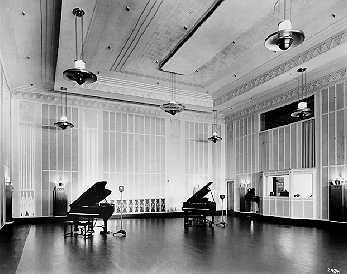|
Studio E
Dimensions:
54 x 42 x 26.5
Decor: "Blue color scheme taken from an old Chinese vase" |
 |
I have seen only
one photograph apart from the one above taken of studio E during its days as a
radio studio. It is part of the collection of a former radio performer who now
lives on the West Coast. I copied the photo on videotape---unfortunately, on tape
to which I do not presently have access.
The photograph, taken around 1933, shows Madame Ernestine Schumann-Heink performing
with an orchestra under the direction of Charles Previn. Madame Schumann-Heink
is remembered for a number of reasons: the longevity of her career; the fact that
two of her sons fought on different sides during World I; and the fact that, in
magazine advertisements, she endorsed Luck Strike cigarettes.
But her most legendary attribute was her girth (she was, in fact, roughly the
size of Joe Camel). The following story is told of her in this regard: on one
occasion, she appeared as a vocal soloist with the Detroit Symphony Orchestra,
then under the direction of Osip Gabrilovitch. Following her performance, and
during her attempted exit from the stage, she became ensnared between the violas
and 'celli. Hopelessly so. Seeing the predicament, Gabrilovitch whispered from
the podium, "Sideways, Madame, Sideways." Schumann-Heink replied, ad
alta voce, "Masetro, I have no sideways!".
The process of studio E's conversion into a television studio began in late 1951.
An NBC press release of October 3rd, 1951 heralded the transformation:
NBC TO SPEND $500,000 FOR NEW TV STUDIO IN NETWORK'S CHICAGO HEADQUARTERS
Reaffirming
its belief in the midwest as a continuing source of television entertainment,
NBC this week announced that it intends spending upwards of a half-million dollars
building a new TV studio in connection with its headquarters in Chicago's Merchandise
Mart. According to Harry Kopf, NBC vice-president and general manager of its Chicago
operations, work will be started almost at once and the new studio is expected
to be in service for programs by the start of the new year.
The new studio will be installed in the area now occupied by the company's radio
studio E. For all except the supporting walls, the project involves a complete
reconstruction of the old studio, and even the walls will be in conformity with
the latest TV studio design when the work is completed. The TV studio that will
result will incorporate all of the latest developments in engineering techniques
and lighting, according to Mr. Kopf. The Rotolector system of switching and dimming
will be employed in the lighting scheme. Kopf pointed out that the chief advantage
of this system is that any desired lighting arrangements can be pre-set for operation
from the main light control board.
The control room will also be designed to take advantage of late developments
in production techniques. In all, three camera chains can be accomodated in the
studio plan, indicating that the studio will be capable of handlinga variety of
assignments ranging from simple to complex programs. Provision is to be made for
dressing rooms in corridor space.
According to Kopf, one of the chief features of the new studio will be the convenience
of its lighting arrangements. A light gallery will be established to run around
the walls, enabling lighting technicians to place illumination at any lateral
point desired. An overhead gridsystem will make it possible to install lighting
and scenic battens at any other overhead point in the studio.
Reconditioning of the studio walls for the special requirements of television,
and installation of power conduits will be the initial step. In all, the plan
calls for 126 individual lighting circuits.
"Because of the number of TV shows we are now producing or have in prospect,
we have been practically bursting at the seams for lack of studio space,"
Kopf stated. "The new studio will help to take some of the pressure off current
production problems and, at the same time, give us a chance to expand in the future,"
he declared.
|
|
The timing of studio
E's conversion was curious. Not long before, NBC had canceled production of the
"Garroway at Large" show, Chicago's premier network television offering.
Not long after, it would scale back "Kukla, Fran and Ollie" from a daily
half-hour to a daily fifteen minutes. Chicago's days as a network television production
center were numbered.
In the short term, the conversion of studio E was an excercize in the development
of excess capacity. But in the long term, it turned out to have been a wise decision.
For beginning in the late 1950's, NBC in Chicago began to divert the energies
it had once applied to entertainment programming to the production of local news
broadcasts. Studio E became the locus of these broadcasts which greatly increased
in number and duration. It was as a news studio that studio E achieved its highest
and best use. |
Comments
or suggestions? click
here to send them to Rich Samuels
Created by
Rich Samuels (e-mail to rich@richsamuels.com)
|